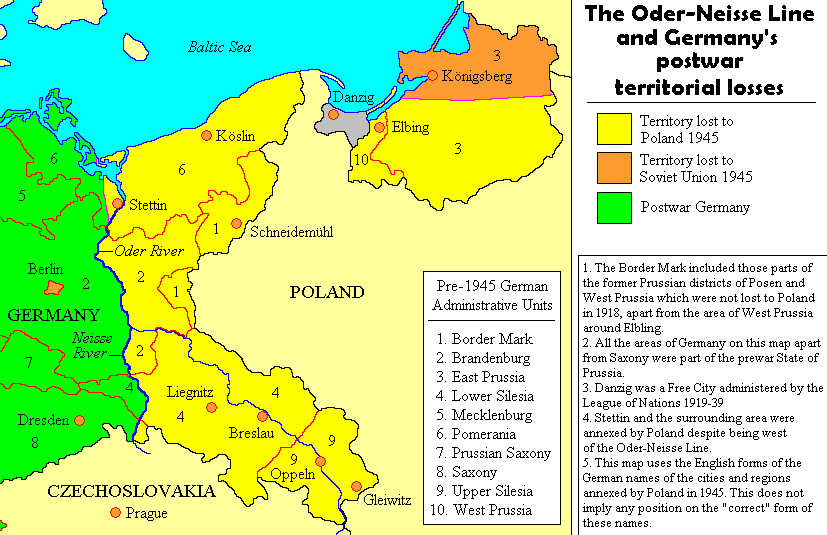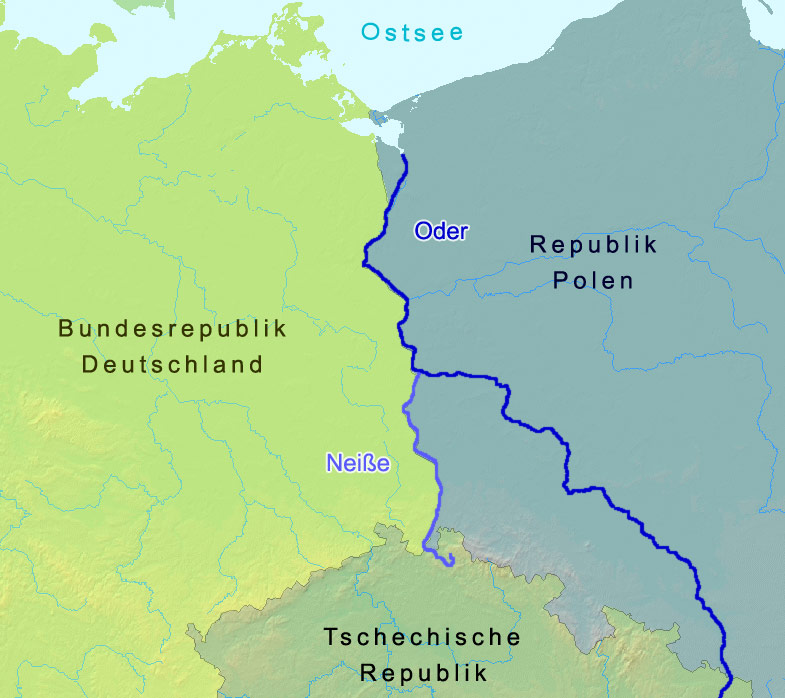|
Oder–Neisse Line
The Oder–Neisse line (german: Oder-Neiße-Grenze, pl, granica na Odrze i Nysie Łużyckiej) is the basis of most of the international border between Germany and Poland from 1990. It runs mainly along the Oder and Lusatian Neisse rivers and meets the Baltic Sea in the north, just west of the ports of Szczecin and Świnoujście (German: ''Stettin'' and ''Swinemünde''). All prewar German territories east of the line and within the 1937 German boundaries—comprising nearly one quarter (23.8 percent) of the Weimar Republic—were ceded under the changes decided at the postwar Potsdam Conference (Potsdam Agreement), with the greatest part becoming part of Poland. The remainder, consisting of northern East Prussia with the German city of Königsberg (renamed Kaliningrad), was allocated to the Soviet Union, as the Kaliningrad Oblast of the Russian SFSR (today Russia). However this did not become completely official until the peace treaty for Germany was signed. The ethnic Germ ... [...More Info...] [...Related Items...] OR: [Wikipedia] [Google] [Baidu] |
Kaliningrad
Kaliningrad ( ; rus, Калининград, p=kəlʲɪnʲɪnˈɡrat, links=y), until 1946 known as Königsberg (; rus, Кёнигсберг, Kyonigsberg, ˈkʲɵnʲɪɡzbɛrk; rus, Короле́вец, Korolevets), is the largest city and administrative centre of Kaliningrad Oblast, a Russian semi-exclave between Lithuania and Poland. The city sits about west from mainland Russia. The city is situated on the Pregolya River, at the head of the Vistula Lagoon on the Baltic Sea, and is the only ice-free port of Russia and the Baltic states on the Baltic Sea. Its population in 2020 was 489,359, with up to 800,000 residents in the urban agglomeration. Kaliningrad is the second-largest city in the Northwestern Federal District, after Saint Petersburg, the third-largest city in the Baltic region, and the seventh-largest city on the Baltic Sea. The settlement of modern-day Kaliningrad was founded in 1255 on the site of the ancient Old Prussian settlement ''Twangste'' by t ... [...More Info...] [...Related Items...] OR: [Wikipedia] [Google] [Baidu] |
Migration Period
The Migration Period was a period in European history marked by large-scale migrations that saw the fall of the Western Roman Empire and subsequent settlement of its former territories by various tribes, and the establishment of the post-Roman kingdoms. The term refers to the important role played by the migration, invasion, and settlement of various tribes, notably the Franks, Goths, Alemanni, Alans, Huns, early Slavs, Pannonian Avars, Magyars, and Bulgars within or into the former Western Empire and Eastern Europe. The period is traditionally taken to have begun in AD 375 (possibly as early as 300) and ended in 568. Various factors contributed to this phenomenon of migration and invasion, and their role and significance are still widely discussed. Historians differ as to the dates for the beginning and ending of the Migration Period. The beginning of the period is widely regarded as the invasion of Europe by the Huns from Asia in about 375 and the ending with the co ... [...More Info...] [...Related Items...] OR: [Wikipedia] [Google] [Baidu] |
Holy Roman Empire 11th Century Map-en
Sacred describes something that is dedicated or set apart for the service or worship of a deity; is considered worthy of spiritual respect or devotion; or inspires awe or reverence among believers. The property is often ascribed to objects (a " sacred artifact" that is venerated and blessed), or places (" sacred ground"). French sociologist Émile Durkheim considered the dichotomy between the sacred and the profane to be the central characteristic of religion: "religion is a unified system of beliefs and practices relative to ''sacred things'', that is to say, things set apart and forbidden." Durkheim, Émile. 1915. ''The Elementary Forms of the Religious Life''. London: George Allen & Unwin. . In Durkheim's theory, the sacred represents the interests of the group, especially unity, which are embodied in sacred group symbols, or using team work to help get out of trouble. The profane, on the other hand, involve mundane individual concerns. Etymology The word ''sacred'' des ... [...More Info...] [...Related Items...] OR: [Wikipedia] [Google] [Baidu] |
Treaty On The Final Settlement With Respect To Germany
The Treaty on the Final Settlement with Respect to Germany (german: Vertrag über die abschließende Regelung in Bezug auf Deutschland; rus, Договор об окончательном урегулировании в отношении Германии, r=Dogovor ob okonchatel'nom uregulirovanii v otnoshenii Germanii ), or the Two Plus Four Agreement (german: Zwei-plus-Vier-Vertrag;; rus, Соглашение «Два плюс четыре», r=Soglasheniye «Dva plyus chetyre» short: German Peace Treaty), is an international agreement that allowed the reunification of Germany in the early 1990s. It was negotiated in 1990 between the Federal Republic of Germany and the German Democratic Republic (the eponymous ''Two''), and the Four Powers which had occupied Germany at the end of World War II in Europe: France, the Soviet Union, the United Kingdom, and the United States; it also replaced the 1945 Potsdam Agreement before. In the treaty, the Four Powers renounced all right ... [...More Info...] [...Related Items...] OR: [Wikipedia] [Google] [Baidu] |
German–Polish Border Treaty
The German–Polish Border Treaty of 1990; pl, Traktat między Rzeczpospolitą Polską a Republiką Federalną Niemiec o potwierdzeniu istniejącej między nimi granicy) finally settled the issue of the Polish–German border, which in terms of international law had been pending since 1945. It was signed by the foreign ministers of Poland and Germany, Krzysztof Skubiszewski and Hans-Dietrich Genscher, on 14 November 1990 in Warsaw, ratified by the Polish on 26 November 1991 and the German on 16 December 1991, and entered into force with the exchange of the instruments of ratification on 16 January 1992. Historical background In the Potsdam Agreement of 1945, the Allies of World War II had defined the Oder–Neisse line as the line of demarcation between the Soviet occupation zone in Germany and Poland, pending the final determination of Poland's western frontier in a later peace settlement. This transferred extensive regions to Poland, some of which had been under Germ ... [...More Info...] [...Related Items...] OR: [Wikipedia] [Google] [Baidu] |
German Reunification
German reunification (german: link=no, Deutsche Wiedervereinigung) was the process of re-establishing Germany as a united and fully sovereign state, which took place between 2 May 1989 and 15 March 1991. The day of 3 October 1990 when the German Reunification Treaty entered into force dissolving the German Democratic Republic (GDR; german: link=no, Deutsche Demokratische Republik, DDR, or East Germany) and integrating its recently re-established constituent federated states into the Federal Republic of Germany (FRG; german: link=no, Bundesrepublik Deutschland, BRD, or West Germany) to form present-day Germany, has been chosen as the customary ''German Unity Day'' () and has thereafter been celebrated each year from 1991 as a national holiday. East and West Berlin were united into a single city and eventually became the capital of reunited Germany. The East Germany's government led by the Socialist Unity Party of Germany (SED) (a communist party) started to falter on 2 May ... [...More Info...] [...Related Items...] OR: [Wikipedia] [Google] [Baidu] |
Revolutions Of 1989
The Revolutions of 1989, also known as the Fall of Communism, was a revolutionary wave that resulted in the end of most communist states in the world. Sometimes this revolutionary wave is also called the Fall of Nations or the Autumn of Nations, a play on the term Spring of Nations that is sometimes used to describe the Revolutions of 1848 in Europe. It also led to the eventual breakup of the Soviet Union—the world's largest communist state—and the abandonment of communist regimes in many parts of the world, some of which were violently overthrown. The events, especially the fall of the Soviet Union, drastically altered the world's Balance of power (international relations), balance of power, marking the end of the Cold War and the beginning of the post-Cold War era. The earliest recorded protests were started in Kazakh Soviet Socialist Republic, Kazakhstan, then part of the Soviet Union, in 1986 with the Jeltoqsan, student demonstrations — the last chapter of these rev ... [...More Info...] [...Related Items...] OR: [Wikipedia] [Google] [Baidu] |
Kniefall Von Warschau
The term ''Kniefall von Warschau'', also referred to as ''Warschauer Kniefall'' (both German for "Warsaw genuflection"), refers to West German Chancellor Willy Brandt kneeling and giving a moment of silence during a visit to a Warsaw Ghetto Uprising memorial in 1970. Incident The event took place on December 7, 1970, in Warsaw, Poland (which was then part of the Eastern Bloc), during a visit to a monument to the German occupation-era Warsaw Ghetto Uprising. After laying a wreath, Brandt unexpectedly, and apparently spontaneously, knelt. He remained silently in that position for a short time (half a minute), surrounded by a large group of dignitaries and press photographers. Brandt had actively resisted the early Nazi regime, and had spent most of the time of Hitler's reign in exile. The occasion of Brandt's visit to Poland at the time was the signing of the Treaty of Warsaw between West Germany and Poland, guaranteeing German acceptance of the new borders of Poland. The t ... [...More Info...] [...Related Items...] OR: [Wikipedia] [Google] [Baidu] |
West Germany
West Germany is the colloquial term used to indicate the Federal Republic of Germany (FRG; german: Bundesrepublik Deutschland , BRD) between its formation on 23 May 1949 and the German reunification through the accession of East Germany on 3 October 1990. During the Cold War, the western portion of Germany and the associated territory of West Berlin were parts of the Western Bloc. West Germany was formed as a political entity during the Allied occupation of Germany after World War II, established from eleven states formed in the three Allied zones of occupation held by the United States, the United Kingdom, and France. The FRG's provisional capital was the city of Bonn, and the Cold War era country is retrospectively designated as the Bonn Republic. At the onset of the Cold War, Europe was divided between the Western and Eastern blocs. Germany was divided into the two countries. Initially, West Germany claimed an exclusive mandate for all of Germany, representing itsel ... [...More Info...] [...Related Items...] OR: [Wikipedia] [Google] [Baidu] |
East Germany
East Germany, officially the German Democratic Republic (GDR; german: Deutsche Demokratische Republik, , DDR, ), was a country that existed from its creation on 7 October 1949 until German reunification, its dissolution on 3 October 1990. In these years the State (polity), state was a part of the Eastern Bloc in the Cold War. Commonly described as a communist state, it described itself as a Socialist state, socialist "workers' and peasants' state".Patrick Major, Jonathan Osmond, ''The Workers' and Peasants' State: Communism and Society in East Germany Under Ulbricht 1945–71'', Manchester University Press, 2002, Its territory was administered and occupied by Soviet Union, Soviet forces following the end of World War II—the Soviet occupation zone of Germany, Soviet occupation zone of the Potsdam Agreement, bounded on the east by the Oder–Neisse line. The Soviet zone surrounded West Berlin but did not include it and West Berlin remained outside the jurisdiction of the GDR. M ... [...More Info...] [...Related Items...] OR: [Wikipedia] [Google] [Baidu] |
Russian Federation
Russia (, , ), or the Russian Federation, is a transcontinental country spanning Eastern Europe and Northern Asia. It is the largest country in the world, with its internationally recognised territory covering , and encompassing one-eighth of Earth's inhabitable landmass. Russia extends across eleven time zones and shares land boundaries with fourteen countries, more than any other country but China. It is the world's ninth-most populous country and Europe's most populous country, with a population of 146 million people. The country's capital and largest city is Moscow, the largest city entirely within Europe. Saint Petersburg is Russia's cultural centre and second-largest city. Other major urban areas include Novosibirsk, Yekaterinburg, Nizhny Novgorod, and Kazan. The East Slavs emerged as a recognisable group in Europe between the 3rd and 8th centuries CE. Kievan Rus' arose as a state in the 9th century, and in 988, it adopted Orthodox Christianity from the Byz ... [...More Info...] [...Related Items...] OR: [Wikipedia] [Google] [Baidu] |







